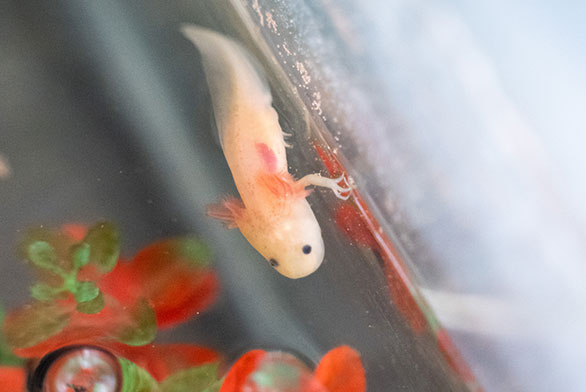‘Axo-What?’ A Brief History of How the Storied Salamander Became Synonymous with St. John’s College
September 13, 2023 | By Philip Psaledakis (SF25)
The axolotl is a valuable component of Freshman Laboratory—and a beloved mascot among Johnnies.
A perennial question in the minds of many Johnnies past and present is how the axolotl became our unofficial campus mascot—and, for that matter, why axolotls in the first place. Where did they come from? What do we use them for? Who brought them here? What even are axolotls? Well, we have these long-awaited answers for you.

The axolotl is a species of salamander from Mexico. Officially known as the Mexican axolotl, it is a unique species of amphibian in that it remains aquatic its entire life. It is also paedomorphic—do you remember your Greek? For those who don’t, being paedomorphic means that the axolotl shows juvenile characteristics throughout its whole life—paedo, signifying child, and morph, signifying shape or form.
The axolotl is a fitting mascot for a small college like St. John’s because they are just as rare as Johnnies. Its native waters are incredibly limited, consisting of just two lakes—Lake Xochimilco and Lake Chalco in the Valley of Mexico, which the Spaniards drained after conquering the Aztec Empire. Today, the axolotl is considered a critically endangered species in the wild. But despite this, their popularity as household pets has skyrocketed over the past two decades. They are also kept in medical labs across the world and studied by scientists for their regenerative capabilities.
The axolotl’s cultural significance has not diminished since historical times: axolotls are named after the Aztec deity Xolotl, the god of fire and lightning. Mexican artist Diego Rivera featured them in his murals. The Argentine novelist Julio Cortázar published a short story entitled “Axolotl” in his 1956 collection End of the Game and Other Stories. They are featured on one of Mexico’s 50-peso banknotes. A star in the constellation Cetus is named after them, the Pokémon Wooper is directly based on the axolotl, and they are even a part of the video game Minecraft. And here at St. John’s College, they are a valuable part of the Freshman Laboratory tutorial.
Axolotls became mainstays in both Annapolis and Santa Fe in the early 2000s, although which campus was technically first seems destined to remain one of those mysteries arising from friendly cross-campus competition. They were brought to the school to be observed by first-year students in the Laboratory Program while studying embryology. “At early stages, axolotl eggs are quite large compared to chicken eggs,” says tutor emeritus William Donahue, the former director of laboratories in Santa Fe. “We can study them under low-power stereoscopes and even see the cleavages of embryonic cells as they happen. Additionally, we get to watch them hatch!”
Through reading such texts as Aristotle’s On Generation and Corruption, Dreisch’s The Science and Philosophy of the Organism, and Spemann’s The Organizer-Effect in Embryonic Development, first-year students question how we can engage with and understand the natural world—how organisms come to be and wither away. The central question of the biology sequence is simply stated, yet incredibly vast: what is life?
Were axolotls always used to study the early stages of life at St. John’s College? No! Before our amphibious friends made their way to our two campuses, we studied the growth of sea urchin eggs. There was, however, an incredible challenge in obtaining their eggs and sperm. To do so, we had to inject them with a concentrated salt solution, thereby killing them off. This death should have theoretically caused the gametes to gush out of the sea urchins and unite in the open water, triggering growth— but since it’s difficult to tell the sex of urchins, many had to be killed to ensure we got enough gametes from each sex for procreation. In fact, a lab assistant at the time dubbed this process “the annual ritual slaughter of the sea urchins.” Plus, we were also trying to breed them out of their usual season. This process seldom worked well enough to produce enough eggs to study across the lab classes, and students frequently had to resort to videos to observe the early stages of growth.
Two Santa Fe students, Elisheba Fay (SF05) and Molly Wright Falconer (SF05) brought axolotls into their lab class with the brilliant idea of studying their eggs. Donahue and his lab assistant (the very same Ms. Fay) soon thereafter attempted an axolotl mating, but the results were unsuccessful. Mr. Donahue then visited the Ambystoma Genetic Stock Center in Lexington, Kentucky, which specializes in breeding axolotls for classroom use across the country, and he returned to Santa Fe prepared to launch an on-campus axolotl laboratory.
Ultimately, both Santa Fe and Annapolis successfully adopted the axolotl for use in their labs, transforming the unique salamander species into a truly institutional phenomenon. From then on, axolotls have been not only a valuable component of Freshman Laboratory, but also a beloved figure in the Johnnie community (and great for marketing too!)

